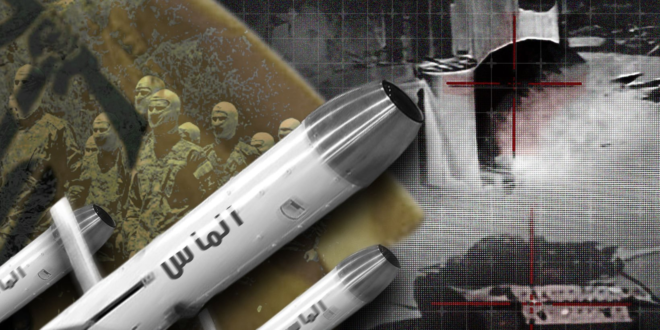Hezbollah’s launch of the Iranian-made Almas missile — reverse-engineered from the Israeli ATGM, Spike — is a major military development in the northern battlefield, and a dismaying surprise for Tel Aviv.
On 25 January, the Lebanese resistance movement Hezbollah orchestrated a bold strike against Israel’s strategic Jal al-Alam site, using what appeared to be a new missile system that immediately captured the attention of war observers.
As seen in a video released by Hezbollah’s media division, the Iranian-made Almas missile appeared to ascend before homing in on its target with extraordinary clarity — thanks to a camera affixed to the projectile itself — prompting widespread buzz about this “special weapon,” its features, and capabilities.
إستـ.ـهداف المقـ.ـاومة الإسلامية تجهيزات تجسسية في موقع رأس الناقورة البحري التابع لجيش العـ.ـدو الإسرائـ.ـيلي بصاروخ موجّه خاصة..
قوة القوة pic.twitter.com/vrjl0Xln3V
— mahdisaade (@mahdisaade1) January 28, 2024
‘Plunging fire’
The Almas is an anti-armor missile equipped with a distinctive “top attack” feature. Unlike traditional systems such as the American TOW, Russian Concourse, or Russian Kornet, which follow a straight trajectory toward the target, this weapon takes an “indirect” path. Operating on an arc trajectory, the missile ascends to a specific altitude before descending toward its target from above.
Why the top-down approach? Armored vehicles, including tanks, prioritize varying thicknesses of armor on different sides to balance weight and maintain mobility. Typically, armor is thickest on the front, less on the sides, and even less on the back or roof.
For instance, a tank’s front armor might be three to four times thicker than its side armor. Consequently, a projectile needs a smaller, more targeted explosive charge to penetrate the tank, specifically from above or the front.
The concept of top-down missiles is not novel, and recent conflicts have seen a surge in their use. In the Second Nagorno-Karabakh war between Azerbaijan and Armenia, Israeli Spike anti-tank missiles wreaked havoc on Armenian vehicles, complemented by Turkish Bayraktar drones dropping projectiles from above. Both weapons rarely failed to break the armor of Soviet-era Armenian tanks, (mostly T-72E and B tanks).
Drones and anti-tank dynamics
The battlefield in Ukraine, it should be said, has been a wider and more geographically and temporally extended arena for experimenting with multiple different types of these munitions.
As air defenses heightened on both sides, larger armed drones like the Bayraktar and its Russian counterpart, the Orion, were sidelined in favor of smaller quadcopters. These nimble drones either drop munitions from the air or act as suicide missions, targeting tanks at their weakest points — namely, the roof, sides, or rear.
Notable anti-armor weapons, such as the US-made Javelin or the British NLAW, initially shifted the balance but later succumbed to conventional two-dimensional anti-armor weapons like the Kornet-inspired Stugna.
Several countries boast portable weapons with top-attack capabilities, including China’s Red Arrow and Japan’s Type 1 LMAT. Notably, Israel possesses a range of such weapons, with the Spike system leading the pack in various sizes and ranges.
The differentiating factor lies in the Spike’s ability to not only employ the “fire-and-forget” (F&F) feature, where the missile autonomously directs itself based on the target image, but also in its semi-automatic guidance across the line of sight. This distinctive feature also surfaced in a recent rocket utilized by the Lebanese resistance in two strikes, leaving analysts speculating on the identity of this advanced weapon.
Iranian engineering excellence
In recent years, Hezbollah’s ally Iran has achieved remarkable advancements across various military technology domains, showcasing prowess in cruise missiles, drones, and air defense systems. A notable addition to this arsenal boasting a top attack feature is the Almas (Diamond) missile, described as a clone of the Spike-MR.
Initially unveiled in a 2020 video, the Diamond made its debut on the global stage with the armed Ababil-3 surveillance and reconnaissance drone, gaining attention at military exhibitions. What distinguishes this weapon is its readiness for export, as evident from appearances not only in Iranian military showcases but also at arms exhibitions abroad.
The screen of the Almas’ scoring device matches the screen that appeared in the one launched by Hezbollah, and the blurred image of the device in the second video of the Naqoura strike matches the shape of the weapon itself, which is mounted on a three-legged base.
للي سأل عن العامود..
ولمن لم يسأل عن الطابة “وينيي”!
بالفيديو | تفنيد ادعاءات العدو الإسرائيلي بشأن مصداقية مشاهد استهداف موقع رأس الناقورة البحري بتاريخ 2024-1-27.#الاعلامالحربي #حزبالله pic.twitter.com/v2yVGDgKD7
— jamal cheaib (@JamalCheaib) January 29, 2024
A similar Iranian anti-tank guided missile, the Sadid-365, which differs from the Almas in various aspects, surfaced in a test video last year. The Naqoura site’s second video revealed a significant change in the rocket’s post-launch behavior, transitioning from a fully-driven system to a lock frame, a departure from the Sadid’s method of scoring.
This locking mechanism appeared to memorize the target’s image, adjusting its course based on the target’s shape rather than a singular point and direction, as observed in the case of the Almas.
Despite the rocket’s upward trajectory in the first video, the missile’s sensor remained fixated on the target. This seemingly complex operation is facilitated by top-down missiles employing a biaxial seeker or “gimbal,” akin to the gyroscope principle used in stabilizing cameras for movement. This feature allows the missile’s researcher to maintain focus on the target while the rocket ascends, directing the hull towards the target when reaching a certain altitude.
Shaking up the northern front
There are three main tactical implications for Hezbollah using this new weapon on the battlefield against the Israeli occupation forces:
First, is to target the enemy’s vulnerabilities: The Almas’ ability to hit Israeli tanks and vehicles from above exploits the weakest angle of their armor. Cages installed on Israeli tanks may offer little defense against such munitions, designed primarily for smaller threats like quadcopter-dropped munitions.
Second, is to defeat Israel’s costly Trophy systems: The Israeli defense system, “Trophy” or “Windbreaker,” proves ineffective against projectiles coming from above.
Third, is complicating Israel’s target searches: Launching the rocket from behind natural barriers, without direct line-of-sight, makes it nigh impossible for enemy forces to locate the shooters or their launch areas. This goes beyond the Israeli struggle with direct missiles like the Kornet; the Almas creates new angles and possibilities that evade traditional search calculations, rendering the old shooting-and-hiding tactics unnecessary.
The ramifications of Hezbollah’s Almas missile disclosure are not just limited to the weapon’s battlefield implications. This tactical “reveal” also places Israel’s military top brass on notice about the potential pitfalls of an expanded conflict with Lebanon.
The cost of conflict for Tel Aviv could significantly increase if the resistance adopts this method to strike the enemy’s military vehicles and gatherings. The weapon’s unique features, including its wired guidance through fiber optic wire, make traditional countermeasures like jamming ineffective.
While the Almas’ existence does not single-handedly alter the strategic outlook of the battles on Israel’s northern front, it complements second-generation anti-armor weapons like the Konkurs. Each weapon on the battlefield plays a specific role, and their integration with shooters and strategic planners is crucial in imposing Hezbollah’s will on the occupation entity.
 Eurasia Press & News
Eurasia Press & News




